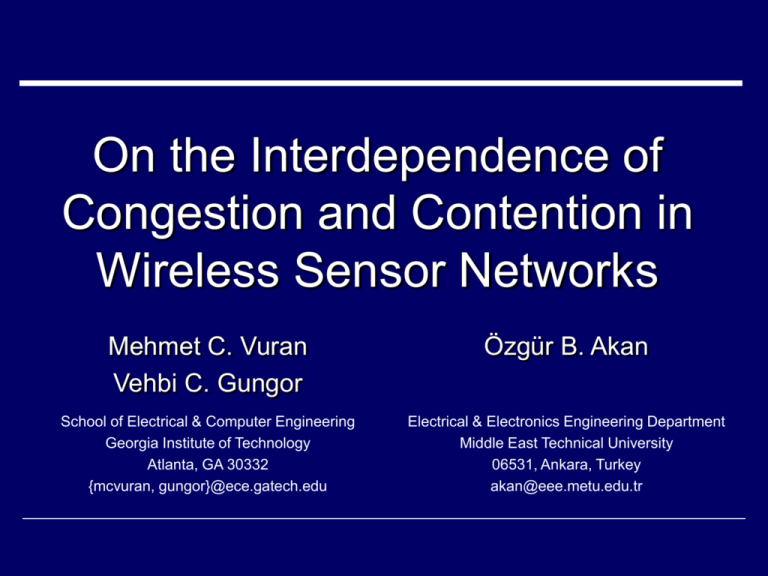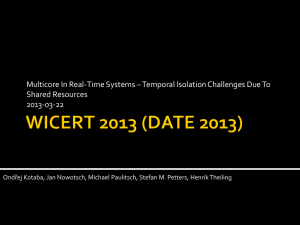On the Interdependence of Congestion and Contention
advertisement

On the Interdependence of
Congestion and Contention in
Wireless Sensor Networks
Mehmet C. Vuran
Vehbi C. Gungor
Özgür B. Akan
School of Electrical & Computer Engineering
Georgia Institute of Technology
Atlanta, GA 30332
{mcvuran, gungor}@ece.gatech.edu
Electrical & Electronics Engineering Department
Middle East Technical University
06531, Ankara, Turkey
akan@eee.metu.edu.tr
Outline
Wireless Sensor Networks (WSN)
Congestion and contention in WSN
Related Work
Goals
Evaluation Environment
Results
Conclusions
Wireless Sensor Networks
Internet,
Satellite,
UAV
Sink
Sink
Several thousand
nodes
Distance of tens of
feet
Densities as high as
20 nodes/m2
Task
Manager
I.F.Akyildiz, W.Su, Y. Sankarasubramaniam, E. Cayirci,
“Wireless Sensor Networks: A Survey”, Computer Networks Journal, March 2002.
I.F.Akyildiz, M.C. Vuran, O. B. Akan, W. Su,
“Wireless Sensor Networks: A Survey REVISITED” Computer Networks Journal, 2005.
Wireless Sensor Networks (WSN)
Characterized by the collaborative information
transmission of densely deployed nodes
High density leads to
Local contention
Network-wide congestion
In fact, the level of local contention and the
network congestion are closely coupled due to
the multi-hop nature of sensor networks
Network Congestion
Network congestion
leads to waste of communication resources
leads to waste of energy resources
hampers event detection reliability at the sink
The WSN architecture employs unique sources
for congestion
Communication in a shared wireless medium
Multi-hop nature of WSN
Limited buffer size
Main Sources for Congestion
Channel Contention and Interference
Contention occurs between
different
flows
different packets of a flow
Outgoing channel capacity becomes time variant
High density exacerbates the impact of contention
Number of Event Sources
Higher number of event sources improve event
detection efficiency
Closely located source nodes increase contention
Increased number of flows increase congestion
Main Sources for Congestion (2)
Packet Collisions
Packet drops due to collisions may indicate lower
congestion level
Reporting Rate
Increasing reporting rate causes network
congestion even if local contention is minimized
Many-to-one Nature
Event communication between multiple sources
and single sink causes bottleneck around the sink
A comprehensive analysis of network congestion
and local contention is required for WSN
Related Work
In [1], channel load information is incorporated into
congestion detection and control mechanisms.
[2] proposes transmission control scheme for use at the
MAC layer.
In [3], congestion detection is performed through buffer
occupancy measurements.
In [4], the backoff window of each node is linked to its
local congestion state.
It has been advocated in [5] that MAC layer support is
beneficial in congestion detection and control algorithms.
[1] C. Y. Wan, et.al., “CODA: Congestion Detection and Avoidance in Sensor Networks,” in Proc. ACM SENSYS 2003,
November 2003.
[2] A. Woo, et.al., “A Transmission Control Scheme for Media Access in Sensor Networks,” in Proc. ACM MOBICOM 2001,
pp.221-235, 2001.
[3] O. B. Akan and I. F. Akyildiz, “ESRT: Event-to-Sink Reliable Transport for Wireless Sensor Networks,” to appear in
IEEE/ACM Trans. Networking, October 2005.
[4] I. Aad, et.al., “Differentiation Mechanisms for IEEE 802.11,” in Proc. IEEE INFOCOM 2001, pp. 209-218, April 2001.
[5] B. Hull, et.al., “Techniques for Mitigating Congestion in Sensor Networks,” in Proc. ACM SENSYS 2004, November 2004.
Related Work (2)
Cross-layer approaches in congestion detection
and control is necessary in WSN
There is a close coupling between local
contention and network-wide congestion
The interdependence of congestion and
contention are yet to be studied
Goals
In this work, we investigate the interactions between
contention resolution and congestion control
mechanisms
What are the consequences of independent operations
of local contention resolution and end-to-end congestion
control mechanisms?
What is the effect of local retransmissions?
What are the effects of network parameters such as
buffer sizes of the sensors, number of sources and
contention window size?
Can cross layer interaction be performed by preserving
the modularity of layered design or are cross-layer
designs required?
Evaluation Environment and
Performance Metrics
ns-2 simulations in a 100x100m2 sensor field
One node selected as sink
Nodes in an event area send information to the
sink
Performance Metrics
Event
Reliability (Rev)
Number of Collisions
MAC Layer Errors
Buffer
Overflows
End-to-end Latency
Energy Efficiency
Number of Sources
Event radius values
non-congested
region
rthlow
transition
region
rthhigh
congested
region
20m, 30m, 40m
As reporting rate is
increased reliability
drops significantly
Increasing number
of sources, i.e.,
event radius,
degrades reliability
A common shape is
observed for
reliability
Number of Sources (2)
Close correlation between MAC layer errors and buffer overflows
Buffer overflows start to build up as MAC layer errors saturate
The maximum value of MAC layer error percentage occurs at rthlow
For higher number of sources, congestion occurs at lower reporting
rate
Buffer Size
Buffer size
values 5, 50,
100, 250
Change in
buffer size
has minimal
effect on
reliability
Buffer Size (2)
Increasing buffer length increases percentage of MAC layer errors
Small buffer sizes lead to lower latency
If end-to-end latency is important, lower buffer sizes lead to
acceptable reliability
Since contention dominates, smaller buffer sizes are actually
beneficial in WSN
MAC Layer Retransmissions
Retransmission
limit values 4, 7, 10
Decreasing local
reliability affects
overall reliability
rthlow occurs at
lower values for
decreased Rtxmax
Increasing Rtxmax
further have
minimal effect on
reliability
MAC Layer Retransmissions (2)
Local reliability level affects MAC layer errors
In the congested region, end-to-end latency increases significantly
Local reliability mechanism has converse effect on end-to-end
latency
Latency saturates in congested region and local reliability level
affects the saturation reporting rate value
Contention Window
Average contention
window values for
source and router
nodes
Source nodes are
located close
Increasing reporting
rate increases
contention
Contention occurs
mainly in the vicinity
of source nodes
Adjusting initial
contention window
size, CWmin, may
affect network
performance
Contention Window (2)
Adjusting buffer
size and CWmin
leads to higher
reliability
In non-congested
region, lower
CWmin size is better
As the reporting
rate is increased,
increasing CWmin
improves reliability
by 10%
Adaptive
contention window
size adjustments
lead to efficient
results
Reasons for Packet Drops
Distribution of packet
drops
In non-congested
region, packet drops
are due to MAC and
routing layers
As reporting rate is
increased, MAC layer
errors saturate and
buffer overflows
dominate
Adaptive reliability
mechanisms are
required considering
traffic load
Energy Efficiency
Energy
consumption
increases with
reporting rate in
non-congested and
transition regions
Energy
consumption
saturates in the
congested region
Number of sources
significantly effect
energy
consumption
Energy Efficiency (2)
Energy consumption is not significantly affected by buffer size or
Rtxmax
The effects of these parameters on other performance metrics
enable energy-aware, adaptive protocols to be implemented
Conclusions
The interdependence between local contention and
network-wide congestion is investigated
Higher event resolution vs. higher contention
Increasing number of sources improves event reliability
Higher contention degrades network performance since
sources are closely located
Small buffer sizes may be beneficial
For low reliability, low latency demanding applications, smaller
buffer size leads to more efficient performance
Local reliability vs. End-to-end reliability
Higher reporting rate can be supported by local reliability
In addition to local reliability, end-to-end congestion and
reliability mechanisms required
Conclusions (2)
Traffic-aware contention window size
The knowledge of reporting rate enables initial contention
window size adjustments
The effect of buffer size change can be given by contention
window size adjustments
Adaptive cross-layer reliability mechanism required
Packet drop distribution changes dynamically
Reliability mechanisms need to adopt to sources of drops
Energy efficient adjustments are possible
Energy consumption is minimally affected by buffer size and
retransmission limit adjustments
Local interactions directly affect overall network
performance




